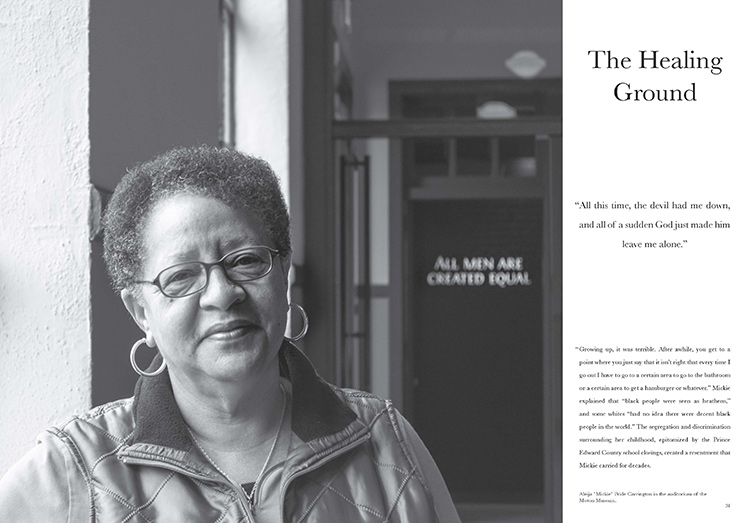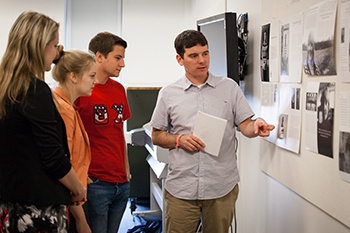The impact on students’ lives of the closing of the Prince Edward County schools from 1959-64 is documented in a magazine produced recently by Longwood University students.
A 52-page magazine, 10 Stories, 50 Years Later tells the stories of the individual experiences of 10 people affected by Prince Edward County’s effort to preserve segregated schools. The magazine is the result of interviews conducted, and photographs taken, in a collaboration between an advanced photography class and an honors English class. The combined class also is a collaboration between Longwood and the nearby Moton Museum.
The magazine is another of several recent projects in which Longwood has partnered with the Moton Museum in commemorating the 50th anniversary of the reopening of public education on an integrated basis in the county where schools were shuttered longer than anywhere else in the country.
"This was not like any other class I’ve taken before," junior Autumn Uptain said of the honors English class. "It was refreshing to be thrown into a different kind of classroom setting. I learned far more than I would have in a traditional class where I just turned in papers and took quizzes."
Uptain is among the 15 students in a section of Active Citizenship: An Advanced Writing Seminar taught by Dr. Heather Lettner-Rust, assistant professor of English, that teamed up this semester with 10 students in a photography class taught by Michael Mergen, assistant professor of art. Dr. Larissa Fergeson, professor of history, a specialist in civil rights history in Virginia, has been a consultant and co-teacher in the project, which is sponsored by a grant from the American Democracy Project.
In what Lettner-Rust called a "happy coincidence," the effort was done in conjunction with the Moton Storytellers Project, in which community members affected by the school closing will be interviewed by local millennials. This was the beginning of that project, which the museum hopes to expand beyond the 10 former students who were interviewed and photographed by Longwood students beginning in early February.
The Longwood students worked in teams that consisted of one or two writers and one photographer. Each team produced a four-page section with two spreads. Topics discussed by the interviewees included the schooling of African-American students in nearby counties, efforts by parents to home-school their students, the civil rights demonstrations in downtown Farmville in 1963 and student experiences at Prince Edward Academy, a private, formerly all-white school that now is Fuqua School.
"This was a different kind of classroom," senior Cara O’Neal said of her experience in the photography class. "You’re not just coming to class and learning to take pictures—you’re learning about the community in which you live. Before the hunger project [in which she participated], I didn’t even know about the closing of the schools. Many other students also came here not knowing about it."
Highlighted selections from the magazine will be shown in an exhibition at the Farmville Community Marketplace [the former Farmer’s Market], 213 North St., that opens with a reception Thursday, April 17, from 5:30 to 8 p.m., with the students in attendance. The exhibition will run through Saturday, April 19.
"This is one of the most exciting versions of English 400 I’ve ever done," said Lettner-Rust. "The two classes always met together, during which they refined their work in critique sessions as they truly worked collaboratively and across disciplines. My students—many of whom were new to interviewing and then converting that to an article for magazine publication—are understanding the intrinsic relationship between aesthetics and verbal rhetoric. And Mike’s students are being pulled into the text world—how text matches or doesn’t match photographs."
Mergen said the project, like the hunger project, gives students experience "beyond the classroom. It equates to projects they will do after Longwood, in which they will work with colleagues and the public, often outside their comfort zone. In a complicated and comprehensive project like this, they learn the highs and the lows of this kind of work, but they also learn to stick with it because it’s important work."
Fergeson, a resident historian at the Moton Museum, has served as the project’s liaison with the museum and the community. "This is an excellent example of the way in which the classroom is becoming de-centered," she said. "It’s been exciting to watch students work in partnership—both with each other and with the community—and to see them understand the importance of this work."
Last spring a similar collaboration by the same two classes, also taught by Mergen and Lettner-Rust, focused on hunger in Farmville and produced a 40-page tabloid-format publication, 17 Portions: Food For Thought.




Leave a Comment